Italy Electric Vehicle Battery Materials Market Size
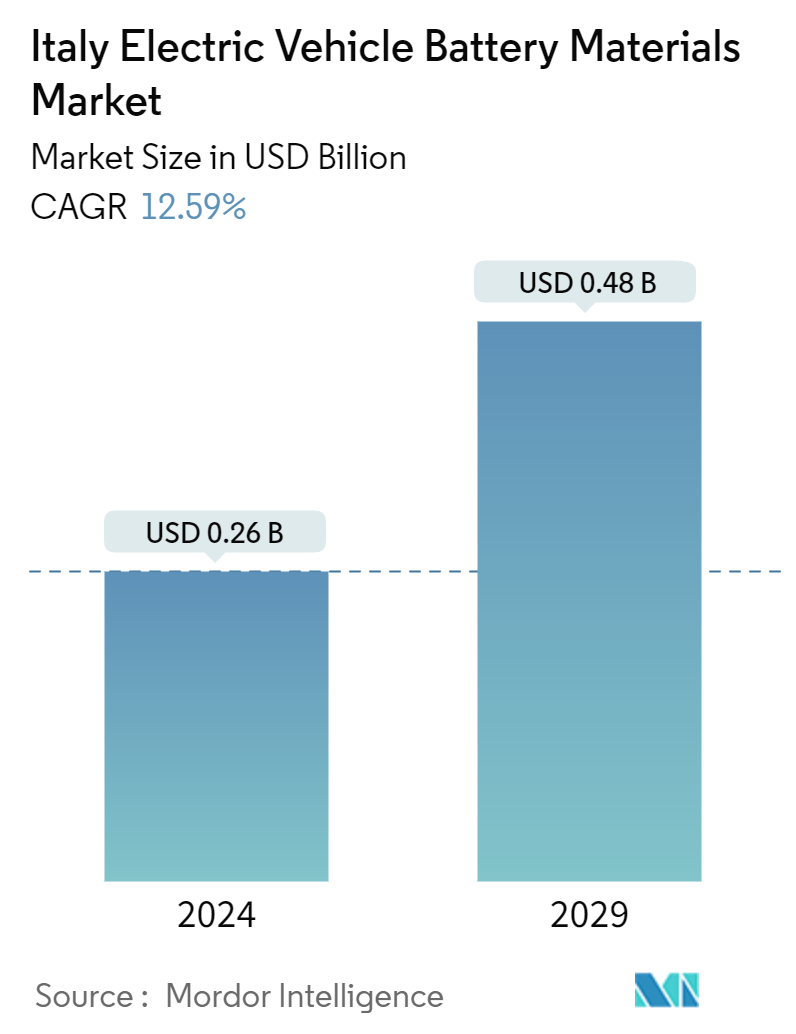
| Study Period | 2019 - 2029 |
| Base Year For Estimation | 2023 |
| Market Size (2024) | USD 0.26 Billion |
| Market Size (2029) | USD 0.48 Billion |
| CAGR (2024 - 2029) | 12.59 % |
| Market Concentration | Low |
Major Players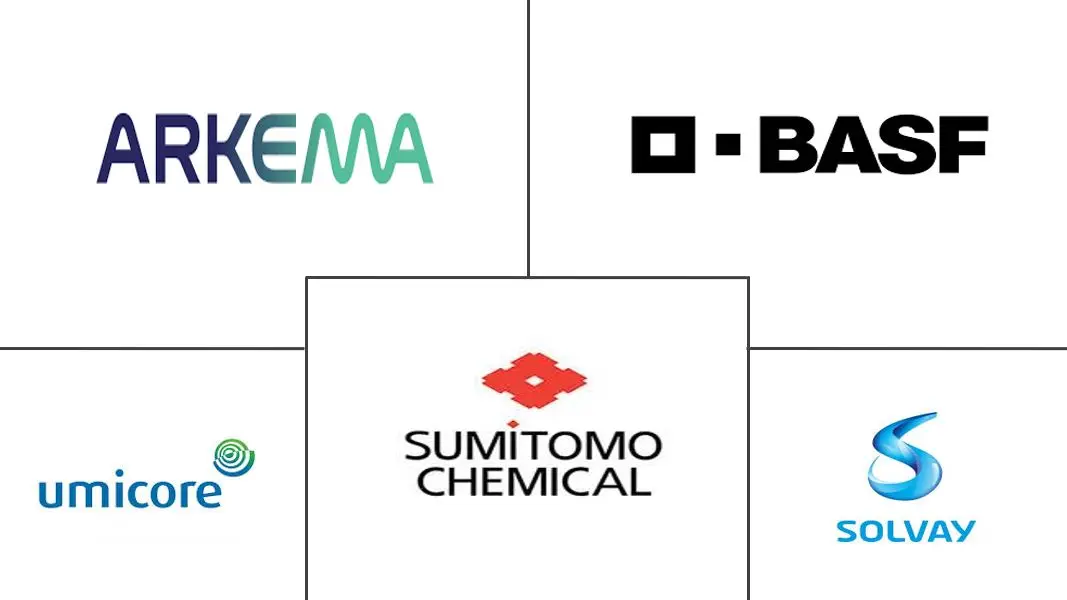
*Disclaimer: Major Players sorted in no particular order |
Italy Electric Vehicle Battery Materials Market Analysis
The Italy Electric Vehicle Battery Materials Market size is estimated at USD 0.26 billion in 2024, and is expected to reach USD 0.48 billion by 2029, at a CAGR of 12.59% during the forecast period (2024-2029).
- Over the medium term, growing electric vehicle (EV) sales and supportive government policies and regulations are expected to drive the demand for electric vehicle battery materials during the forecast period.
- On the other hand, the lack of raw material reserves can significantly restrain the growth of the electric vehicle battery materials market.
- Nevertheless, technological advancements in batteries like higher energy density, faster charging times, improved safety, and longer lifespan are expected to create significant opportunities for electric vehicle battery materials market players in the near future.
Italy Electric Vehicle Battery Materials Market Trends
Growing Electric Vehicle (EVs) Sales Drives the Market
- Rising electric vehicle (EV) sales in Italy are driving up the demand for EV battery materials in the region. As sales of EVs climb, so does the need for key battery components like lithium, cobalt, nickel, and graphite. This heightened demand is not only boosting local production but also attracting investments, thereby strengthening Italy's battery material supply chain.
- Italy is making a concerted shift towards clean energy, with electric vehicles taking center stage. Over recent years, EV sales in Italy have seen a remarkable surge. For instance, the International Energy Agency (IEA) reported that in 2023, Italy sold 136,000 electric vehicles, marking a 19.29% increase from 2022. With numerous projects and initiatives recently rolled out by the European government, EV sales are poised for significant growth, subsequently driving up the demand for battery materials.
- The Italian government is actively nurturing the EV market, rolling out subsidies, tax incentives, and enforcing stricter emission regulations. These supportive measures not only bolster the EV market but also extend their benefits to the battery material industry. The government has set ambitious targets, aiming for a fourfold increase in EV sales in the coming years.
- For instance, in 2023, Italy pledged an annual allocation of EUR 650 million (USD 709 million) for both 2023 and 2024. This funding is aimed at incentivizing the purchase of electrified and low-emission vehicles. The incentives cover plug-in hybrids and hybrids, with potential subsidies reaching up to EUR 4,000 (USD 4,368). Such robust initiatives are set to not only boost EV production and sales but also elevate the demand for battery materials in the coming years.
- Italy's dynamic EV market is driving innovations in battery technology. Local firms are collaborating with global leaders to develop next-gen materials that promise better energy density, longer lifespans, and enhanced safety for EVs. Major players in the region are uniting efforts, anticipating a significant uptick in demand for advanced EV batteries.
- For instance, in February 2024, StoreDot showcased a groundbreaking battery that can achieve a 100-mile charge in just five minutes. Their ambitious timeline aims to reduce this to three minutes by 2028 and an impressive two minutes by 2032. In a strategic collaboration, StoreDot has licensed this innovative technology to Italvolt, which is set to kick off production in Italy. Such advancements are poised to not only boost the demand for sophisticated EV batteries but also amplify the need for battery materials in the region.
- Given these developments, it's clear that the momentum in EV sales and the corresponding demand for battery materials is set to continue its upward trajectory.
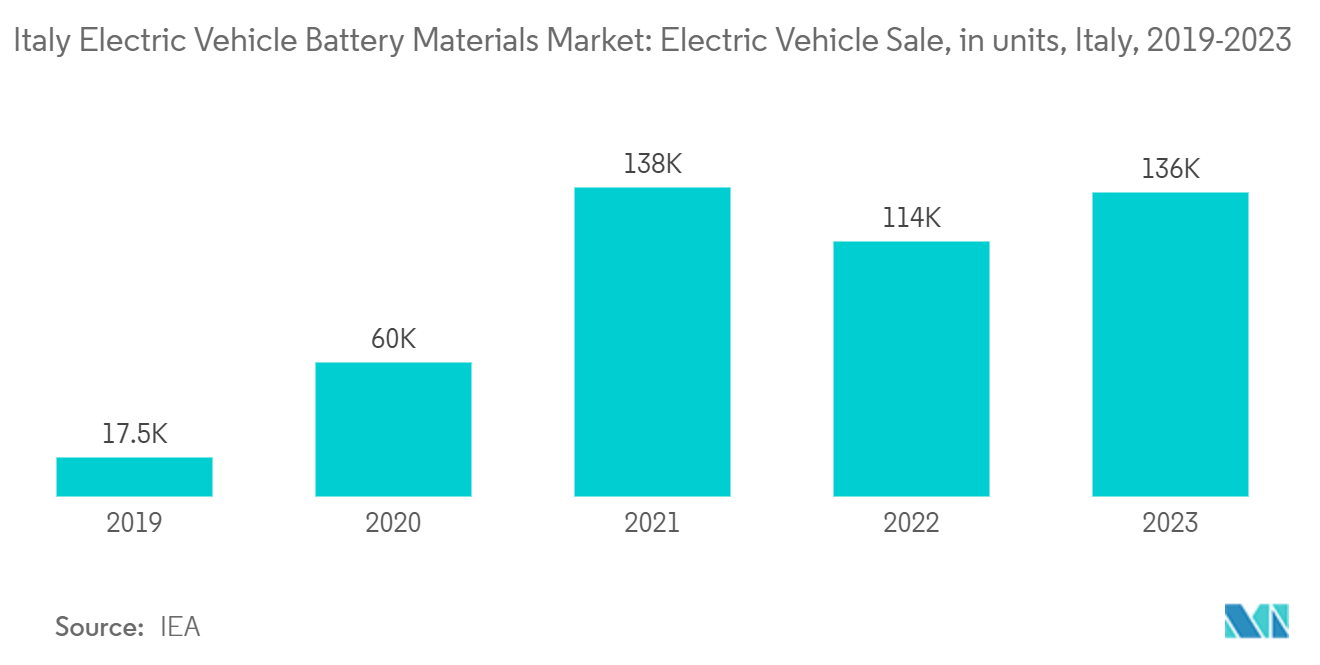
Lithium-Ion Battery Type Dominate the Market
- The rising production of lithium-ion batteries for electric vehicles (EVs) has significantly shaped the battery materials market. This surge in manufacturing has heightened the demand for lithium, with its regional discoveries directly influencing raw material costs.
- In response to this trend, major market players are intensifying their investments in lithium reserves and R&D initiatives. Their objective is twofold: to amplify lithium-ion battery production and to satisfy the surging demand for battery raw materials. As new reserves are discovered, prices for lithium-ion batteries are experiencing a marked decline.
- For example, in 2023, battery prices notably dropped to USD 139/kWh, a 13% decrease. Given the current pace of technological advancements and manufacturing efficiencies, experts forecast prices could further decline to USD 113/kWh by 2025 and plummet to USD 80/kWh by 2030.
- Moreover, in response to escalating environmental concerns, the Italian government is vigorously championing lithium-ion battery production for electric vehicles. With a keen focus on achieving net-zero carbon emissions, the government has launched multiple initiatives to boost lithium-ion battery production, aiming to meet the region's growing EV demand.
- For instance, in February 2024, Automotive Cells Company secured a USD 4.7 billion fund to establish three lithium-ion battery gigafactories in France, Germany, and Italy. This venture, backed by industry giants like Stellantis, Mercedes-Benz, and Saft (a TotalEnergies subsidiary), underscores the commitment to lithium-ion batteries as a pivotal clean energy source, suggesting a surge in battery material demand in the coming years.
- In recent years, Italy has emerged as a leader in pioneering advanced technologies for recycling lithium-ion batteries. Both companies and research institutions are innovating methods to efficiently extract valuable materials—like lithium, cobalt, and nickel—from these batteries.
- For instance, in January 2024, Iveco Group, an Italian truck and bus manufacturer, partnered with BASF, a leading German chemicals firm, to recycle lithium-ion batteries for its electric vehicles (BEVs). While the financial details of the collaboration remain under wraps, it resonates with Iveco's circular economy vision, emphasizing battery lifespan extension and minimizing environmental impact. Such collaborations not only expedite the production of lithium-ion raw materials but also forecast an uptick in EV battery material production.
- Consequently, these advancements and initiatives are poised to boost lithium-ion battery production and significantly elevate the demand for EV battery materials in the coming years.
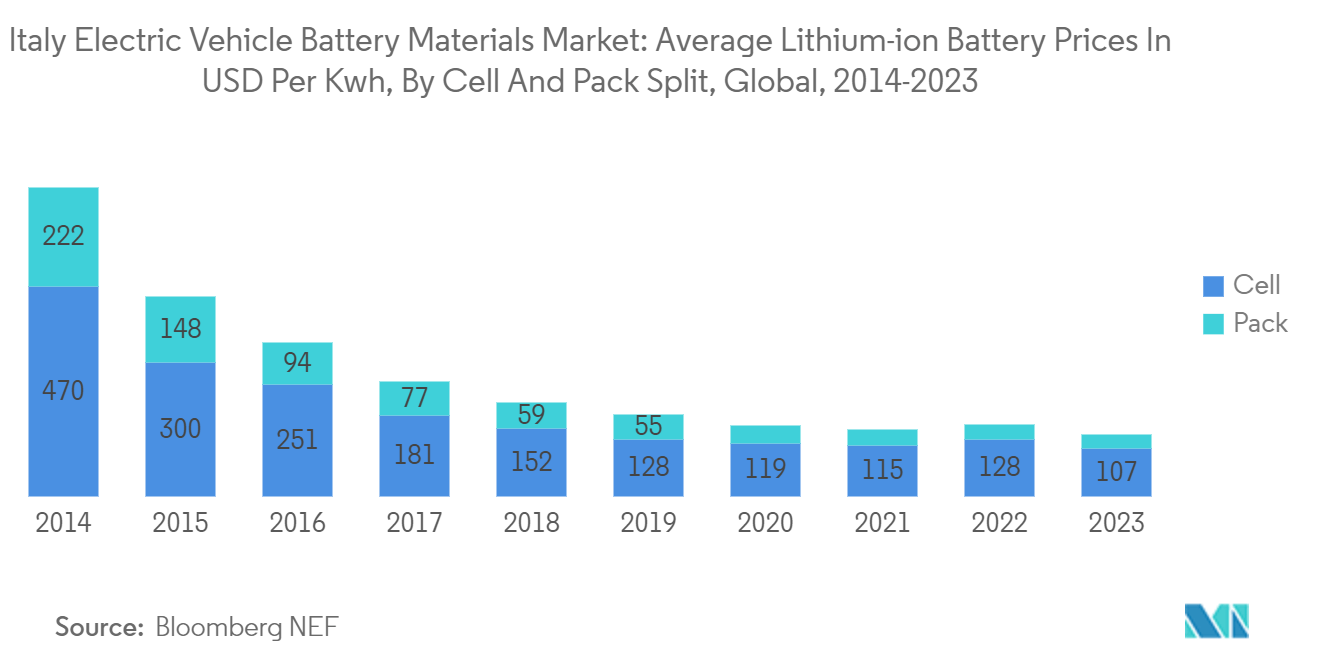
Italy Electric Vehicle Battery Materials Industry Overview
Italy's electric vehicle battery materials market is semi-fragmented. Some key players (not in particular order) are Sumitomo Chemical Co., Ltd., BASF SE, Arkema SA, Solvay SA, Umicore SA, among others.
Italy Electric Vehicle Battery Materials Market Leaders
-
Sumitomo Chemical Co., Ltd
-
Arkema SA
-
Solvay SA
-
BASF SE
-
Umicore SA
*Disclaimer: Major Players sorted in no particular order
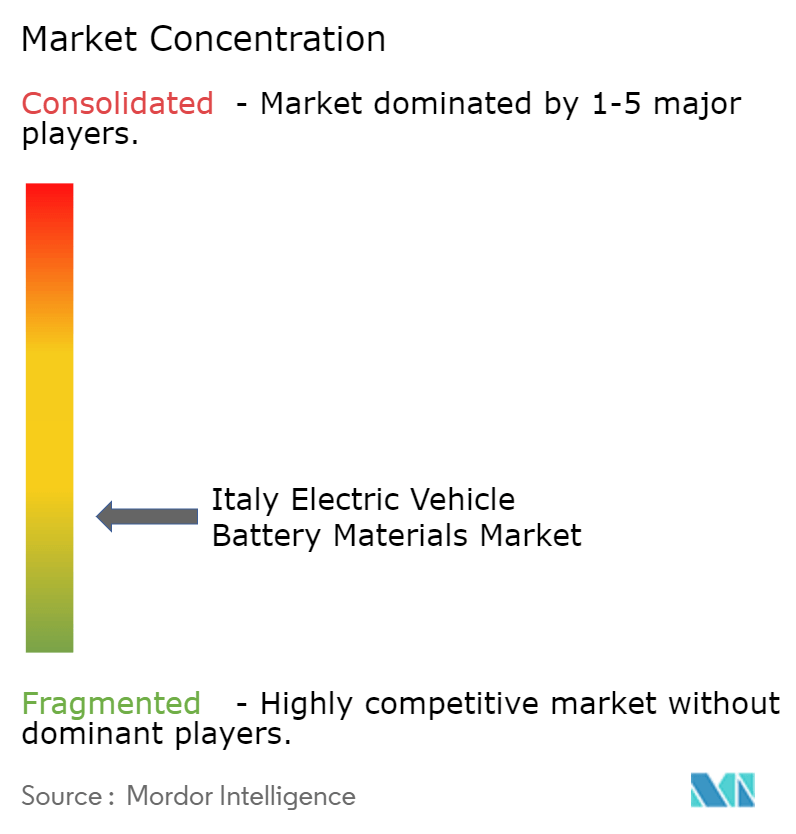
Italy Electric Vehicle Battery Materials Market News
- April 2024: Ferrari unveiled a new laboratory to research lithium battery cells, to produce its first full-electric supercar by the end of 2025. The facility, led by the University of Bologna, will focus on analyzing solid states, fast charging, thermal charging, and cell safety and performance.
- January 2024: EIT InnoEnergy and Demeter Investment Managers announced the launch of a fund dedicated to developing a resilient and diverse battery raw material supply chain in Europe. With a target size of EUR 500 million (USD 544.5 million), the EBA Strategic Battery Materials Fund is building to boost domestic capacities for EV battery materials such as lithium, nickel, cobalt, manganese, and graphite.
Italy Electric Vehicle Battery Materials Market Report - Table of Contents
1. INTRODUCTION
1.1 Scope of the Study
1.2 Market Definition
1.3 Study Assumptions
2. EXECUTIVE SUMMARY
3. RESEARCH METHODOLOGY
4. MARKET OVERVIEW
4.1 Introduction
4.2 Market Size and Demand Forecast in USD billion, till 2029
4.3 Recent Trends and Developments
4.4 Government Policies and Regulations
4.5 Market Dynamics
4.5.1 Drivers
4.5.1.1 Growing Electric Vehicle Sales
4.5.1.2 Supportive Government Policies and Regulations
4.5.2 Restraints
4.5.2.1 Dependence on Raw Material Supply
4.6 Supply Chain Analysis
4.7 PESTLE Analysis
4.8 Investment Analysis
5. MARKET SEGMENTATION
5.1 Battery Type
5.1.1 Lithium-ion Battery
5.1.2 Lead-Acid Battery
5.1.3 Others
5.2 Material
5.2.1 Cathode
5.2.2 Anode
5.2.3 Electrolyte
5.2.4 Separator
5.2.5 Others
6. COMPETITIVE LANDSCAPE
6.1 Mergers and Acquisitions, Joint Ventures, Collaborations, and Agreements
6.2 Strategies Adopted by Leading Players
6.3 Company Profiles
6.3.1 Sumitomo Chemical Co., Ltd.
6.3.2 BASF SE
6.3.3 Arkema SA
6.3.4 Solvay SA
6.3.5 Umicore SA
6.3.6 Midac Batteries
6.3.7 FIB S.p.A
6.3.8 Ferroglobe
6.3.9 SGL Carbon
6.3.10 Fiamm Energy Technology
- *List Not Exhaustive
6.4 List of Other Prominent Companies
6.5 Market Ranking/ Share Analysis
7. MARKET OPPORTUNITIES AND FUTURE TRENDS
7.1 Advancements in Battery Technology
Italy Electric Vehicle Battery Materials Industry Segmentation
Electric vehicle (EV) battery materials refer to the raw materials and compounds used in the manufacturing of batteries specifically designed for electric vehicles. These materials are critical for the performance, energy density, lifespan, and safety of EV batteries.
Italy's electric vehicle battery materials market is Segmented by Battery Type and Material. By battery type, the market is segmented into Lithium-Ion Battery, Lead-Acid Battery, and Others. By materials, the market is segmented into Cathode, Anode, Electrolyte, Separator, and Others. The Report Offers the Market Size and Forecasts in Revenue (USD) for all the Above.
| Battery Type | |
| Lithium-ion Battery | |
| Lead-Acid Battery | |
| Others |
| Material | |
| Cathode | |
| Anode | |
| Electrolyte | |
| Separator | |
| Others |
Italy Electric Vehicle Battery Materials Market Research FAQs
How big is the Italy Electric Vehicle Battery Materials Market?
The Italy Electric Vehicle Battery Materials Market size is expected to reach USD 0.26 billion in 2024 and grow at a CAGR of 12.59% to reach USD 0.48 billion by 2029.
What is the current Italy Electric Vehicle Battery Materials Market size?
In 2024, the Italy Electric Vehicle Battery Materials Market size is expected to reach USD 0.26 billion.
Who are the key players in Italy Electric Vehicle Battery Materials Market?
Sumitomo Chemical Co., Ltd, Arkema SA, Solvay SA, BASF SE and Umicore SA are the major companies operating in the Italy Electric Vehicle Battery Materials Market.
What years does this Italy Electric Vehicle Battery Materials Market cover, and what was the market size in 2023?
In 2023, the Italy Electric Vehicle Battery Materials Market size was estimated at USD 0.23 billion. The report covers the Italy Electric Vehicle Battery Materials Market historical market size for years: 2019, 2020, 2021, 2022 and 2023. The report also forecasts the Italy Electric Vehicle Battery Materials Market size for years: 2024, 2025, 2026, 2027, 2028 and 2029.
Italy Electric Vehicle Battery Materials Industry Report
Statistics for the 2024 Italy Electric Vehicle Battery Materials market share, size and revenue growth rate, created by Mordor Intelligence™ Industry Reports. Italy Electric Vehicle Battery Materials analysis includes a market forecast outlook for 2024 to 2029 and historical overview. Get a sample of this industry analysis as a free report PDF download.



